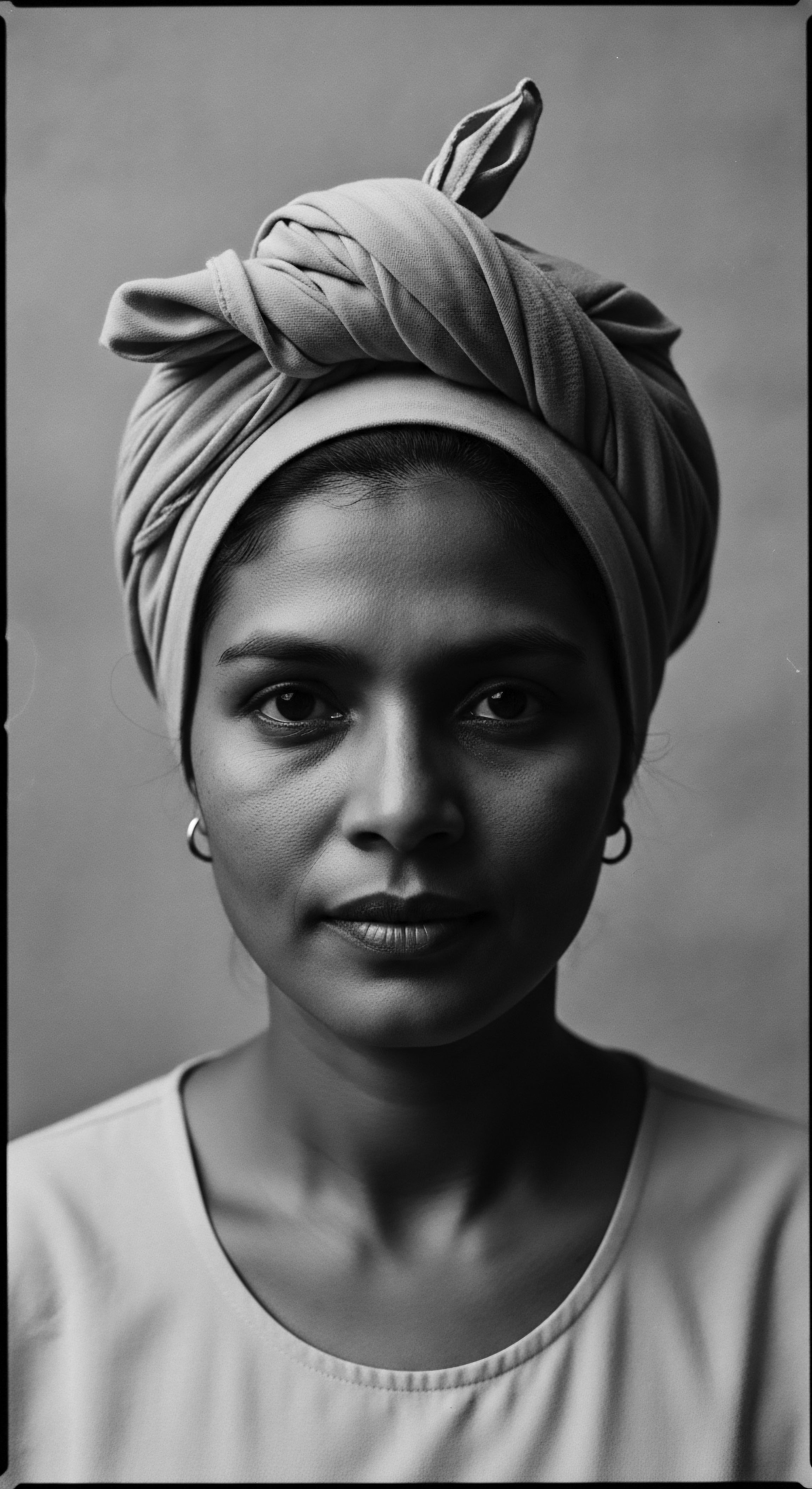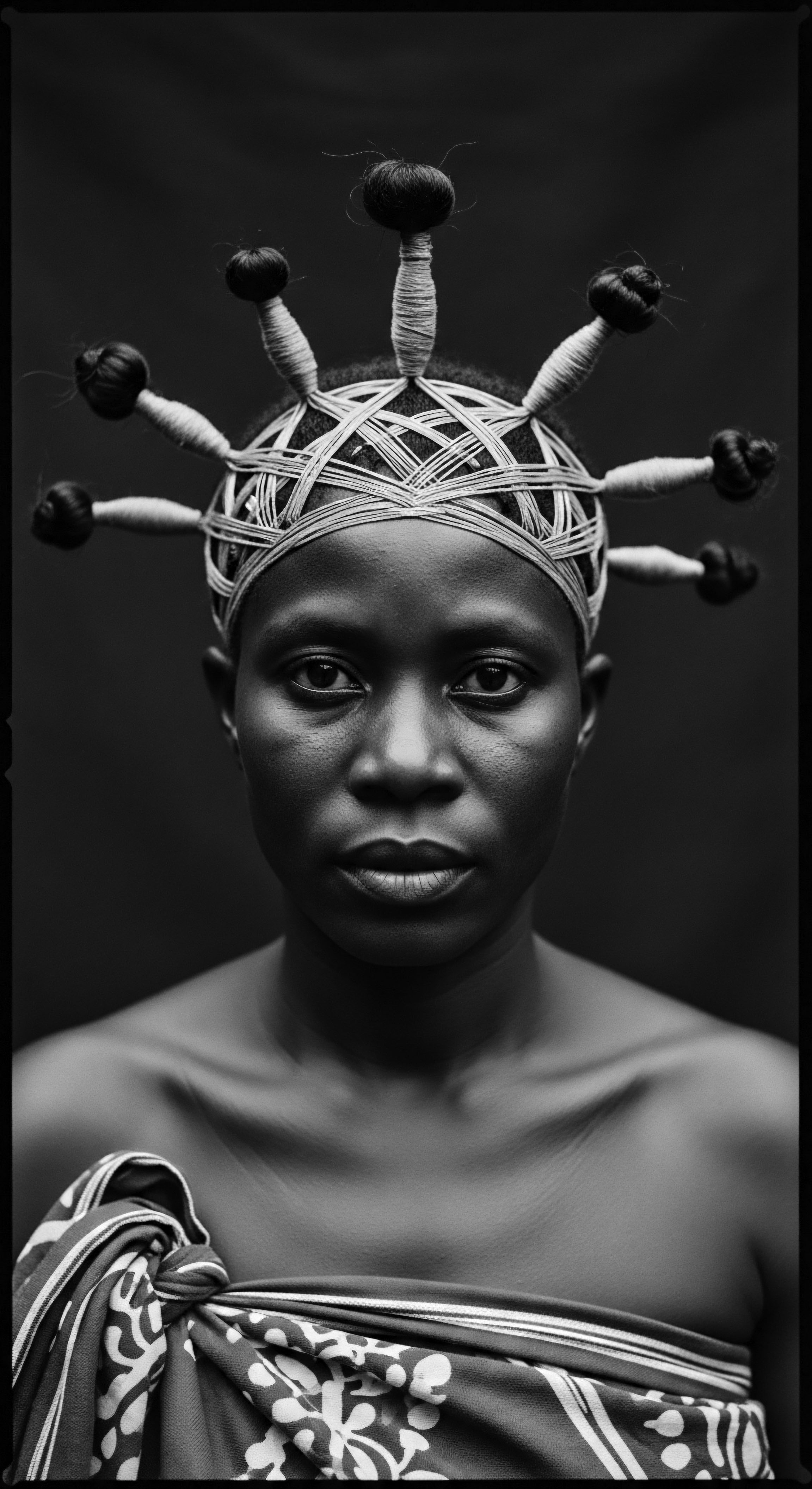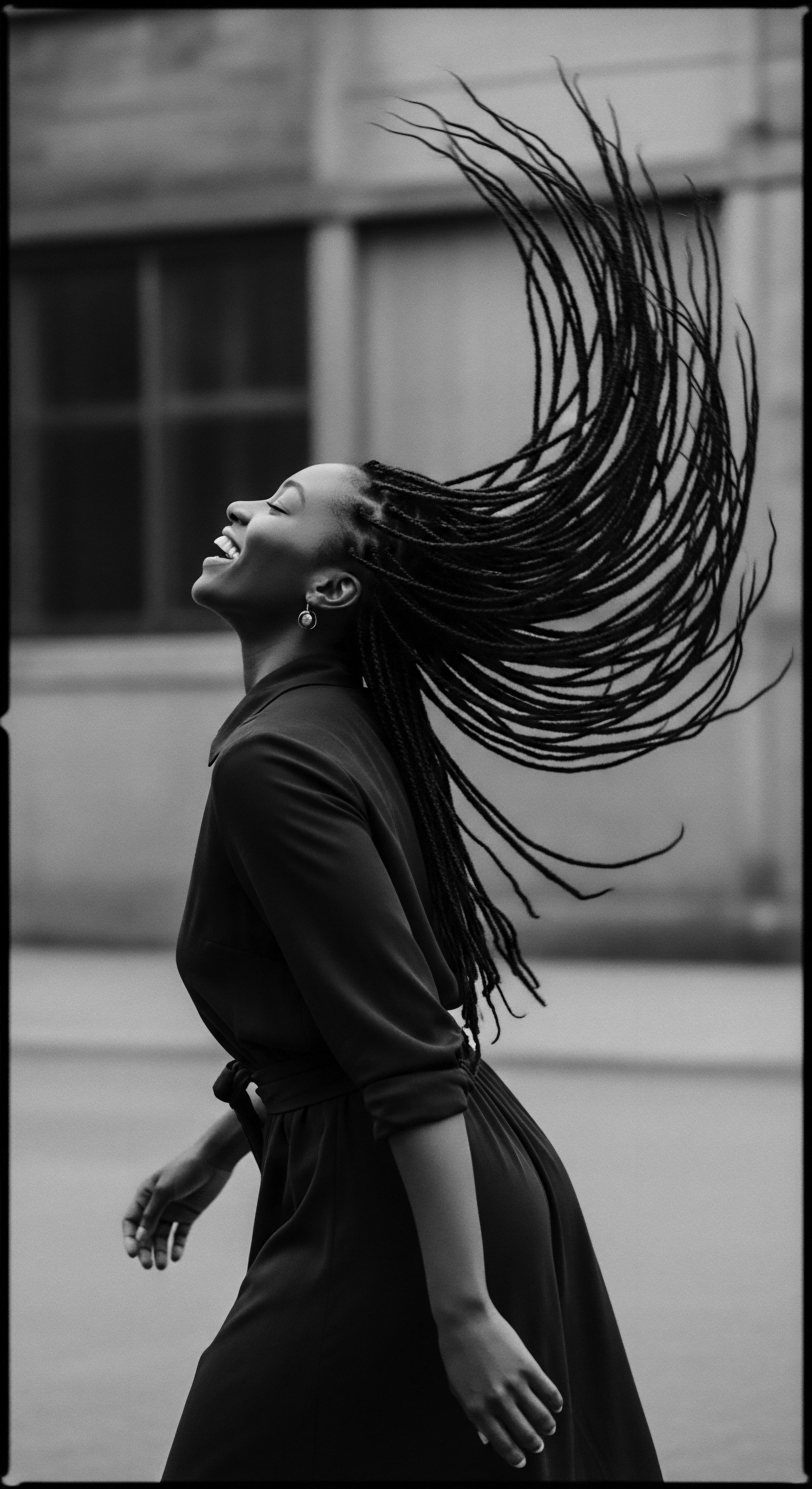
Roots
Consider the vibrant tapestry of textured hair, each strand a whisper of ancestry, a testament to journeys across continents and through time. For generations, Black and mixed-race communities have sought solace and strength in nature’s offerings for the care of their crowning glory. Within the emerald embrace of the Amazon, a collection of oils has not merely nourished strands; they have woven themselves into the very fabric of identity, speaking a language of resilience and deep, abiding heritage. These oils, gathered with ancient wisdom and practiced hands, provide a profound definition for textured hair, revealing its innate need for rich moisture, protective fortitude, and soulful reverence.
The unique coiled and curled architecture of textured hair, a marvel of biological design, naturally presents challenges in moisture retention. Sebum, our body’s own conditioning balm, struggles to travel the intricate spirals from scalp to tip, leaving the hair susceptible to dryness and breakage. This inherent characteristic means textured hair yearns for external moisture, a truth understood by ancestors who turned to the abundant flora of their homelands. The Amazon, a cradle of biodiversity, offers a botanical treasury, with certain oils emerging as pivotal to the care and celebration of this hair type.

The Sacred Geometry of Hair
To truly grasp what Amazonian oils provide, we must first appreciate the inherent structure of textured hair. Unlike straight hair, which allows oils to glide along its smooth cuticle, textured hair, with its elliptical shaft and varying curl patterns, possesses a more open cuticle layer. This openness, while contributing to its magnificent volume and definition, also makes it more prone to moisture loss. Understanding this biological blueprint allows for a deeper appreciation of ancestral practices that sought to seal and protect, often with the very oils that define our conversation today.
The rich, verdant depths of the Amazon have long held botanical secrets for hair, understanding its inherent need for profound hydration and gentle protection.
Among the botanical riches of the Amazon, one oil, Patauá Oil (Oenocarpus bataua), stands as a powerful symbol of heritage and inherent suitability for textured hair. Sourced from the fruit of the Patauá palm, a tree reaching impressive heights of 25 meters, this oil has been a staple in Amazonian communities for centuries. Its composition mirrors that of olive oil, yet its unique properties make it especially suited for coils and curls. Patauá oil is particularly rich in oleic acid (Omega 9), which offers excellent moisturizing properties and aids in revitalizing hair.
Its light texture ensures that it penetrates hair shafts without weighing them down, a constant concern for those with delicate yet dense textured hair.

How do Amazonian Oils Address Textured Hair’s Inherent Needs?
The ancestral wisdom surrounding Patauá oil extends beyond mere application. Indigenous populations traditionally soak the Patauá fruits in lukewarm water, then boil the pulp to separate the precious oil, a process that speaks to generations of careful observation and practice. This oil serves not only as a hair tonic, used to address hair loss and support growth, but also finds its place in local diets and traditional medicine. The deep understanding held by these communities regarding the Patauá palm’s multifaceted applications highlights a connection to nature that transcends simple utility, grounding hair care deeply in cultural practice and heritage.
- Patauá Oil ❉ Rich in oleic acid, provides deep hydration and restorative properties, traditionally used to fortify hair and address hair loss.
- Oleic Acid ❉ A primary fatty acid in Patauá oil, it offers moisturizing effects that help revitalize hair and soothe the scalp.
- Hair Cuticle ❉ The outer layer of hair, often more open in textured strands, making deep penetration by specific oils particularly beneficial.

Ritual
The history of textured hair care, particularly within Black and mixed-race communities, is a living, breathing archive of ritual. These are not simply steps in a routine; they are acts of remembrance, of connection to those who came before. The careful application of oil, the rhythmic braiding, the communal gathering around a shared practice — each gesture holds centuries of inherited knowledge. Amazonian oils, with their profound ties to ancestral lands, have played a silent yet potent role in these deeply rooted customs, influencing techniques, tools, and the very transformations seen in textured hair across generations.
Consider the Pracaxi Oil (Pentaclethra macroloba), extracted from the seeds of a majestic Amazonian tree. It offers intense hydration and deep conditioning, especially suitable for curly, dry, or very coarse hair. This oil, remarkably high in behenic acid, possesses a natural affinity for strengthening hair fibers and enhancing shine, making it a valuable ally in traditional styling. The use of such oils in historical contexts was often intertwined with community well-being, not merely individual beauty.

Ancestral Hands, Ancient Methods
The women of the Amazon, through generations of lived experience, refined the methods for extracting and utilizing these plant treasures. The rudimentary cooking of dry Pracaxi seeds and macerating them in a mortar to extract oil speaks to a direct, unadulterated relationship with the source. Such practices, though often replaced by modern mechanical pressing, held a ceremonial weight, connecting the user directly to the land and the wisdom embedded within its bounty. This connection goes beyond the botanical; it touches the spiritual.
Hair rituals, spanning generations, embody a profound legacy of self-care and community bonding, deeply connected to the Earth’s natural gifts.
In many Indigenous Amazonian communities, hair care was and remains an act imbued with spiritual and cultural significance. For the Siekopai Nation of the Ecuadorian Amazon, for example, certain plants were traditionally used to dye and strengthen hair. While the cited example pertains to wituk (Genipa Americana), a fruit used for dyeing and strengthening, it underscores the broader practice of utilizing forest resources for hair health and adornment within their cultural practices.
This connection to the land and its offerings for hair care is a powerful testament to the enduring heritage of Amazonian peoples. These traditional practices often focused on not just the physical benefits, but also the preservation of identity and the strengthening of communal bonds.

How Have Amazonian Oils Shaped Styling Traditions?
The unique characteristics of textured hair often led to protective styling, techniques that safeguard the hair from environmental elements and mechanical stress. Oils like Pracaxi, with their ability to reduce frizz and provide a polished finish, would have been indispensable in creating and maintaining these styles. Its reputed “Cinderella effect” in removing frizz speaks to a long-understood need for smooth, manageable hair, even before scientific terminology existed to describe such benefits. These traditions were not static; they evolved, influenced by migration, trade, and cultural exchange, yet the core principles of using natural, locally sourced ingredients remained central.
| Oil Patauá Oil |
| Ancestral Application Hair tonic for growth, addressing hair loss; culinary use. |
| Contemporary Relevance for Textured Hair Deep conditioning, frizz reduction, promoting strength and shine; widely used in modern hair products. |
| Oil Pracaxi Oil |
| Ancestral Application Hair softening, shine, ease of combing; traditional remedy for skin conditions. |
| Contemporary Relevance for Textured Hair Intense hydration, frizz control, improving elasticity, scalp health; valued for curls and coily hair. |
| Oil Buriti Oil |
| Ancestral Application Skin and hair protection from sun, beauty rituals for lustrous hair. |
| Contemporary Relevance for Textured Hair Natural UV protection, color preservation, deep conditioning for dry, damaged hair. |
| Oil These oils, rooted in deep heritage, bridge ancient wisdom with current textured hair care needs, offering a legacy of botanical care. |
The very tools used in traditional hair care, from combs carved from wood to fibers used for wrapping and braiding, were often products of the same ecosystem that yielded these oils. The rhythmic act of applying oil and then shaping the hair became a communal activity, a moment of connection and shared cultural knowledge. This shared experience underscores a profound heritage, where self-care was a collective endeavor, reinforcing identity and belonging within the community.

Relay
The journey of textured hair care, from ancient practices to our current understanding, is a continuous relay, each generation passing down wisdom while adapting to new knowledge and circumstances. At the heart of this enduring transmission lies the profound connection between holistic well-being and the vitality of hair. Amazonian oils, steeped in ancestral wisdom, continue to inform contemporary approaches to hair health, offering solutions to common challenges while strengthening the ties to a rich cultural lineage.
Consider the daily dance with moisture, a central theme for those with coils and curls. Textured hair, by its very nature, demands consistent hydration to maintain its structure and guard against breakage. This ongoing need is precisely where oils like Patauá, Pracaxi, and Buriti Oil (Mauritia flexuosa) truly affirm their worth. Buriti oil, sourced from the “tree of life” thriving in Amazonian wetlands, holds a remarkable concentration of beta-carotene, a natural form of Vitamin A, and essential fatty acids.
This composition makes it particularly effective in conditioning dry, damaged hair and offering natural sun protection, a benefit understood and applied by Indigenous Amazonians for centuries.

The Sacred Sleep and Hair’s Embrace
The care of textured hair extends into the quiet hours of night. Nighttime rituals, such as wrapping hair or using protective head coverings, are not modern inventions; they are echoes of ancestral wisdom. The bonnet, a ubiquitous symbol of textured hair care today, mirrors historical practices of safeguarding strands during rest. These protective measures, often coupled with the application of nurturing oils, allowed hair to retain moisture, prevent tangling, and maintain its intricate styles, ensuring longevity and health.
The wisdom of ancestral care, particularly for textured hair, continues to light the way for modern, holistic well-being.
The very act of oiling the hair before sleep, a widespread practice across diverse Afro-diasporic and Indigenous communities, serves as a testament to this continuous relay of knowledge. It is a moment of calm, a whispered conversation between the self and heritage, allowing the healing properties of these oils to work undisturbed. This ritual fosters a profound sense of self-care, a legacy passed down through generations, emphasizing the hair as a sacred extension of being.

How do Amazonian Oils Offer Solutions for Textured Hair’s Challenges?
Textured hair often faces particular challenges, including dryness, frizz, and susceptibility to breakage. The specific molecular structures and fatty acid profiles of Amazonian oils make them uniquely suited to address these concerns. For instance, the small, polar molecules of certain oils, like Rahua Oil (also Ungurahua Oil, Oenocarpus bataua, which is essentially the same as Patauá oil but often marketed under the Rahua name due to a brand’s discovery and popularization), are noted for their ability to penetrate the hair cortex, strengthening the strand from within rather than merely coating the surface. This deeper penetration is vital for truly repairing and supporting the hair’s inherent structure, leading to sustained resilience and elasticity.
This understanding of how these oils interact with hair at a microscopic level, though articulated in modern scientific terms, validates centuries of observed efficacy by ancestral practitioners. The persistent use of such oils across generations in communities, particularly among women in the Amazon who are noted for their long, lustrous hair, speaks to this deeply ingrained knowledge. The very existence of brands built on these discoveries, stemming from direct engagement with Indigenous communities, underscores the profound influence of ancestral practices on contemporary hair care.
The journey of Afro-Brazilian communities in the Amazon provides a powerful historical example of resilience and adapted ancestral practices. During the 19th century, self-liberated Afro-Brazilian individuals sought refuge in remote Amazonian jungles, establishing Quilombos (settlements founded by escaped enslaved people) where they strove to preserve their identity and traditions. While specific accounts detailing the use of Amazonian oils for hair care within these quilombos can be difficult to isolate, their very existence within the Amazon biome, combined with the documented heritage of using natural ingredients for self-care in Afro-Brazilian culture, strongly suggests an adaptation and integration of local Amazonian plant wisdom into their hair practices.
These communities, already rich in hair traditions from their African heritage, would have intuitively turned to the abundant botanical resources of their new home, just as Indigenous communities had done for millennia. This continuous thread of resourceful adaptation and the incorporation of natural remedies from the local environment into established heritage practices speaks volumes about the enduring spirit of self-preservation and cultural continuity.
- Quilombos ❉ Settlements formed by self-liberated Afro-Brazilians, representing resilience and the continuation of cultural practices in new environments.
- Hair Cortex ❉ The inner layer of the hair shaft, which Rahua (Patauá) oil can reportedly penetrate due to its small molecular size, leading to deeper repair.
- Holistic Influences ❉ Hair health viewed as an extension of overall well-being, a concept rooted in many ancestral wellness philosophies.
The formulation of personalized hair regimens, drawing from ancestral wisdom, now blends seamlessly with modern scientific understanding. This allows for a deeper appreciation of why specific oils, like those from the Amazon, are so effective. The focus shifts from merely treating symptoms to nurturing the hair from its very foundation, honoring its heritage, and ensuring its vibrant future.

Reflection
The dialogue surrounding what Amazonian oil defines textured hair ultimately leads us to a deeper contemplation of heritage itself. It becomes clear that no single oil carries this definition in isolation; rather, it is the collective wisdom, the generations of skilled hands, and the enduring connection to the living rainforest that paints this portrait. The spirit of Roothea’s “Soul of a Strand” finds profound resonance in this exploration, acknowledging that each curl, each coil, carries not merely genetic information, but the very stories of survival, adaptation, and cultural continuity.
These botanical treasures, from the nourishing Patauá to the protecting Buriti, act as conduits, linking us to the ancestral practices that honored hair as a living extension of self and community. They remind us that true beauty care extends beyond superficial appearance, delving into realms of identity, historical memory, and a profound respect for the natural world. The resilience of textured hair, often facing challenges both environmental and societal, mirrors the resilience of the communities that have cherished it.
As we look to the future, the lessons whispered by these Amazonian oils become even more potent. They prompt a re-evaluation of our relationship with nature, encouraging us to seek knowledge from ancient traditions, to listen to the Earth, and to honor the cycles of growth and renewal. The legacy of textured hair care, deeply infused with Amazonian botanical heritage, stands as a living library, a testament to the enduring power of wisdom passed down through time, guiding us toward a more soulful, respectful, and genuinely radiant path for every strand.

References
- Benefits of Botanical Oils From The Amazon Based On Research. Flora Amazon, 2024.
- Incredible Benefits of Amazonian Oils in Hair Care. OSKA Pure, 2023.
- Nativilis Virgin Pataua Oil (Oenocarpus bataua) High Concentration Omega 9 – Refreshing Emollient Restorative Hydrating nourishes Hair Roots to The Ends Restore Prevents Hair Loss – Copaiba Benefits. Amazon.co.uk.
- Buriti Oil ❉ Celebrating International Day of the World’s Indigenous People. O&3, 2023.
- 6 Benefits of Pataua Oil for Hair & Skin. Little Extra, 2023.
- Patauá oil – Oenocarpus Bataua Fruit Oil. Cosmacon.
- Buriti Oil – Mauritia Flexuosa Fruit Oil – Buriti Palm. Cosmacon, 2023.
- Patauá (Oenocarpus bataua). Amazon Oil.
- What are the benefits of Buriti oil for hair? Lunasha Essentials, 2024.
- Brazil’s Authentic Beauty. Buy Brazil Store, 2025.
- The Secret to Perfect Curls ❉ Amazonian Oils for Hydration, Shine, and Strength. Mlk_shake, 2024.
- All About Amazonian Oils! Nourished Life.
- One Amazonian Nation’s Battle to Return Home. Amazon Frontlines.
- The Cultural Significance Of Natural Hair In Different Communities. The Kurl Kitchen, 2024.
- Pracaxi oil. Ellemental.
- Legendary Amazon Oil. Rahua.com.
- Pracaxi (Pentaclethra macroloba). Amazon Oil.
- Natural Oils Native Americans used for Long, Healthy, and Soft Hair. Sister Sky, 2023.
- Buriti oil. W. Ulrich GmbH.
- The Legend Lives On ❉ Legendary Amazon Oil. Rahua.com, 2018.
- Ancestral culture and traditions in the Ecuadorian Amazon. Expedition Ecuador.
- How do the last indigenous tribes live without any contact with civilization? CaixaForum, 2022.
- Wild Harvested Exotic Pracaxi Skin + Hair Oil. Etsy.
- Rahua ❉ The Ancient Amazon Rainforest Secret for Healthy Hair. Parvati Magazine, 2024.
- Colombia ❉ Yanchama and the Guardians of the Forest. Earth Journalism Network, 2023.
- The discovery of an ancient Amazon hair treatment launched this brand. Cosmetics Design, 2019.
- MAKISAKI Pracaxi Oil 120ml – Restore Hair with Amazon’s Vitality. eBay.
- Rahua Shampoo Unveiled ❉ The Amazonian Secret Behind Truly Healthy Hair. Medium, 2025.
- In Brazil’s Amazon, Quilombolas fight the erasure of their African heritage. Mongabay, 2022.
- Afro-Brazilian religions and audiovisual narratives in Amazonia ❉ research tools. SciELO.
- The SoCal City Kids 2018 Mother’s Day Gift Suggestions!
- A Review of Potential Use of Amazonian Oils in the Synthesis of Organogels for Cosmetic Application. MDPI.
- These are the Best Hair Oils for YOUR Hair Type. Beautycon.com, 2024.
- Conceptual Design of the Process for Making Cosmetic Emulsion Using Amazonian Oils.
- Hair Oils ❉ Indigenous Knowledge Revisited. PMC.
- African Presence in the Amazon ❉ A Glance Chapter 13.
- Brazilian nun works to raise Black teen girls’ self-esteem in Amazon. The Catholic Sun, 2021.
- Ayahuasca teaches in Europe. Amazônia Real, 2017.
